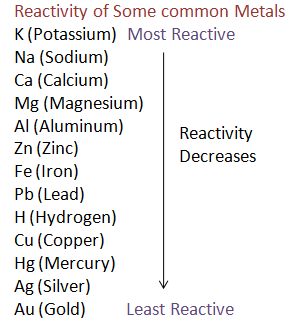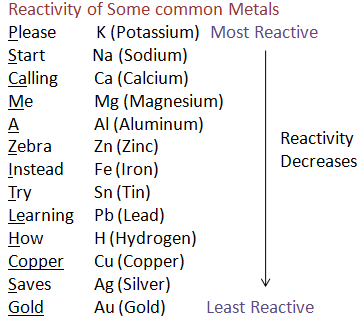
Which of the following metals is the most reactive?
(A) Fe
(B) Zn
(C) Ca
(D) Al
Answer
582.9k+ views
Hint: The more reactive metals always displace less reactive metals from the latter’s compounds to form their own. In other ways we can also relate their reactivity with their oxidation potential that they both are directly proportional to each other.
Complete step by step solution:
To be able to answer this question effectively, we need to first understand what the reactivity series of metals really is and what is its order. So, let us first begin by trying to understand this concept.
The metal reactivity series involves the placement of metals, as its name suggests, in order of reactivity from most reactive to least reactive. It’s also a useful tool in predicting the products of simple displacement reactions involving two different metals, as well as providing an insight into why different metals are extracted from their ores in different manners.

Group 1 metals, the most reactive metals in the periodic table, lead the rankings. They’re closely followed by the marginally less reactive group two metals. The metals designated as the transition metals in the periodic table are much less reactive, and metals such as gold and platinum prop up the bottom of the series, exhibiting little in the way of chemical reaction with any everyday reagents.
- Another way is to compare their oxidation potentials as oxidation potential shows the ability of metals to get oxidised. If metal will react, they will only get oxidised. So, we can say that both oxidation potential and reactivity of metals are directly proportional to each other. Oxidation potential of Fe, Zn , Ca and Al is 0.44, 0.76, 1.66 and 2.87 volts respectively.
Therefore, by this reactivity order of metals, we can safely conclude that the answer to this question is (C) Ca.
Note: An effective mnemonic device to help remember the reactivity order of metals is:
Please Start Calling Me A Careless Zebra, Instead Try Learning How Copper Saves Gold.

Complete step by step solution:
To be able to answer this question effectively, we need to first understand what the reactivity series of metals really is and what is its order. So, let us first begin by trying to understand this concept.
The metal reactivity series involves the placement of metals, as its name suggests, in order of reactivity from most reactive to least reactive. It’s also a useful tool in predicting the products of simple displacement reactions involving two different metals, as well as providing an insight into why different metals are extracted from their ores in different manners.

Group 1 metals, the most reactive metals in the periodic table, lead the rankings. They’re closely followed by the marginally less reactive group two metals. The metals designated as the transition metals in the periodic table are much less reactive, and metals such as gold and platinum prop up the bottom of the series, exhibiting little in the way of chemical reaction with any everyday reagents.
- Another way is to compare their oxidation potentials as oxidation potential shows the ability of metals to get oxidised. If metal will react, they will only get oxidised. So, we can say that both oxidation potential and reactivity of metals are directly proportional to each other. Oxidation potential of Fe, Zn , Ca and Al is 0.44, 0.76, 1.66 and 2.87 volts respectively.
Therefore, by this reactivity order of metals, we can safely conclude that the answer to this question is (C) Ca.
Note: An effective mnemonic device to help remember the reactivity order of metals is:
Please Start Calling Me A Careless Zebra, Instead Try Learning How Copper Saves Gold.

Recently Updated Pages
Two men on either side of the cliff 90m height observe class 10 maths CBSE

What happens to glucose which enters nephron along class 10 biology CBSE

Cutting of the Chinese melon means A The business and class 10 social science CBSE

Write a dialogue with at least ten utterances between class 10 english CBSE

Show an aquatic food chain using the following organisms class 10 biology CBSE

A circle is inscribed in an equilateral triangle and class 10 maths CBSE

Trending doubts
The shortest day of the year in India

Why is there a time difference of about 5 hours between class 10 social science CBSE

Write a letter to the principal requesting him to grant class 10 english CBSE

What is the median of the first 10 natural numbers class 10 maths CBSE

The Equation xxx + 2 is Satisfied when x is Equal to Class 10 Maths

What is the missing number in the sequence 259142027 class 10 maths CBSE




